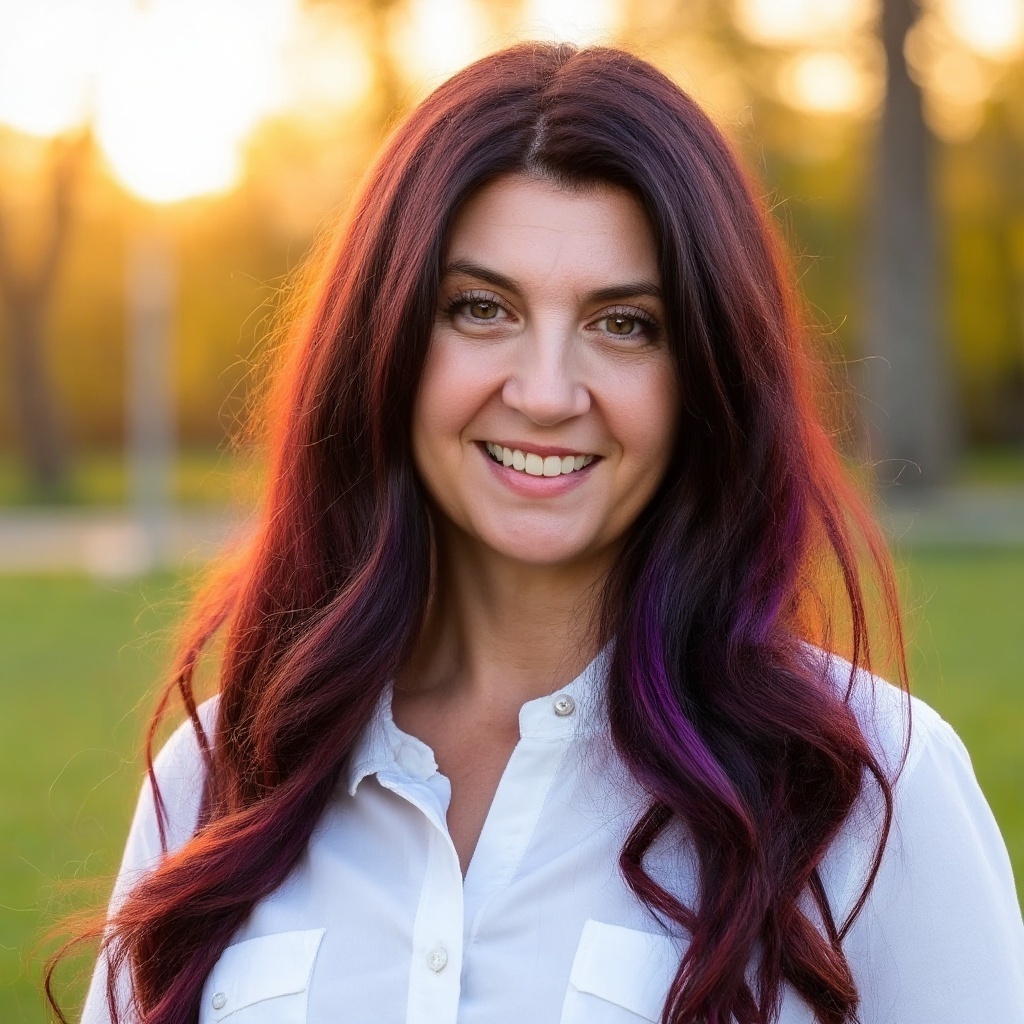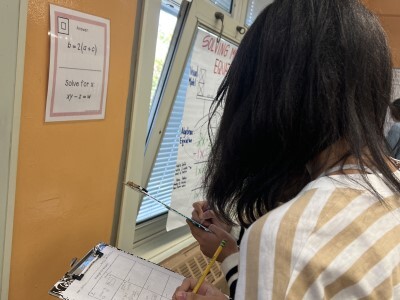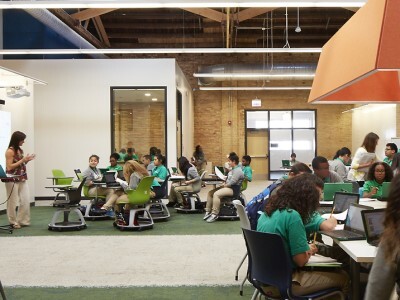From Service Cliff to Launch Pad: Transitioning Forward beyond Special Education
Topics
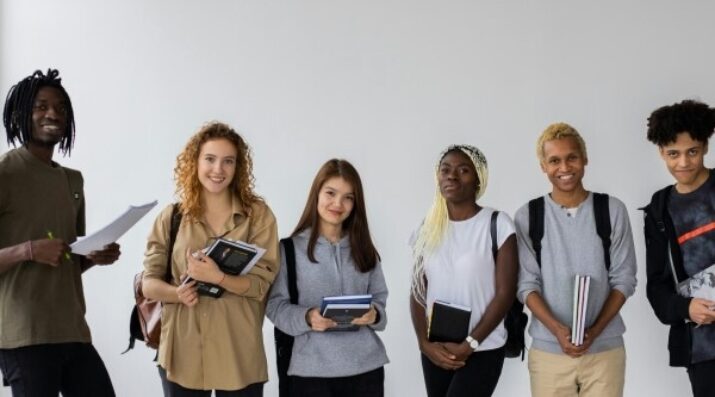
We’ve all had the experience of truly purposeful, authentic learning and know how valuable it is. Educators are taking the best of what we know about learning, student support, effective instruction, and interpersonal skill-building to completely reimagine schools so that students experience that kind of purposeful learning all day, every day.
When students age out of special education at 22, it doesn’t have to feel like the edge of a cliff. With preparation, partnership, and belief, it can be a path forward—cleared, supported, and full of possibility.
What Comes Next: Empowering Possibility Beyond 22
For families navigating the self-contained world, a student’s 22nd birthday can feel like a critical and uncertain milestone. It’s a moment that often brings more questions than answers—a time when lifelong services begin to fade and new pathways aren’t always clear. But it doesn't have to be the end of the road. For students in self-contained programs, turning 22 isn’t a finish line—it’s a chance to grow in new directions. With the right tools, mindset, and support, it doesn’t have to be a cliff at all. It can be a bridge to meaningful, connected, purpose-driven lives. Families, educators, and advocates don’t need to brace for the drop—we can rise with a plan. Let’s start asking not “Where will they go?” but “What can they create next?”
Independence Is Grown—It’s a Process
One of the most important seeds to plant early is student voice. When we teach self-advocacy, communication, and the power of making mistakes, we are building lifelong success skills. Starting in ninth grade—or earlier—students should be encouraged to express opinions, make choices, and reflect on their preferences. These moments aren't just developing soft skills; students are practicing survival skills. They teach students that their voice matters, that teamwork is a tool, and that failure is part of the learning process.
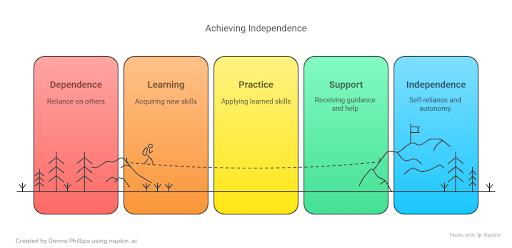
Credit: Donna Phillips
As a teacher, I model this daily—and I’ve learned that when you give students high expectations, they rise to meet them. Visiting educators and substitutes are often surprised by how thoughtfully students in my self-contained classroom participate in discussions, offering deep reflections and meaningful opinions. This doesn’t happen by accident. I believe students are capable of more—every student learns differently, so that’s how I teach. I scaffold, encourage, and create space for each learner to grow into their own version of success.
Tending Real-Life Roots in the Classroom
In our special education classroom, we blend academic instruction with daily living skills, vocational readiness, and communication strategies. Students fold laundry and practice writing resumes. They learn to cook and complete math through budgeting. They build routines that matter—because routines are the foundation for functioning beyond the school walls. These aren’t just activities. They are investments in a student’s autonomy.
We also integrate technology in ways that mirror real-world use. Students practice setting alarms, navigating digital schedules, and using GPS apps. These tools, often overlooked, are gateways to independence. One student learned to check bus schedules online and now independently after graduation plans outings with support staff.
Connecting Students to Their Community
Equally important is cultivating community connection. We partner with local businesses for job sampling, teach students how to navigate public transportation, and involve them in service learning. Whether greeting customers at a pet store, volunteering at a local event, or shopping for groceries, students begin to see themselves as part of something larger. These experiences plant the seeds of confidence and belonging.
We also involve students in campus-based enterprises—coffee carts, garden projects, or school store roles that build transferable job skills. These initiatives foster leadership, time management, and accountability while reinforcing collaboration with general education peers.
Growth You Can See
One student who, as a freshman, cried during the second week of school is now a confident sophomore who raises his hand and contributes to class discussions—often drawing insightful connections between historical topics and current events. Another student has embraced the concept of the circle of control and is learning to regulate his emotions with greater awareness and confidence. These milestones didn’t come overnight—they came from years of consistent, strength-based teaching and believing in the power of growth.
Another student who once relied on scripted conversations during community-based instruction is now able to order his lunch independently, holding natural conversations with cashiers, confidently asking questions and requesting assistance. These real-life moments matter—they reflect social growth that cannot be measured by standardized testing but are performance based assessments that signal readiness in the real world.
Nurturing the Next Season
But the work doesn’t end in the classroom. Families need clear guidance and support to navigate post-22 options. Pre-Employment Transition Services (Pre-ETS) training—offered in my state of Nevada through the Bureau of Vocational Rehabilitation (BVR) and the Department of Employment, Training & Rehabilitation (DETR)—takes place while students are still in high school, which is a powerful opportunity to build real-world skills early. Adult service agencies like BVR and DETR should be engaged early and often—especially since some families need support navigating the paperwork, applications, and unfamiliar processes. The transition section of an IEP is more than just a formality—it’s a doorway to the future. It’s where school teams and families begin mapping out real-life goals beyond graduation. But not every parent knows how this piece connects to adult services or that it’s backed by the Individuals with Disabilities Education Act (IDEA)—a federal law that ensures students with disabilities receive the support and services they need to succeed in school and beyond. That’s where schools have the chance to do something powerful: to walk alongside families, break things down in plain language, and build a plan that actually feels possible. When we approach transition planning with care and intention, we’re not just preparing for life after high school—we’re planting the seeds for lifelong confidence, independence, and purpose.
Too often, students are sent off with a generic packet and good intentions. What they need is a customized map and a network that doesn’t dissolve the moment they turn 22—a map that grows with them, updated with every new experience, skill, and aspiration. With the right tools and a steady support system, that transition can become a launchpad—one rooted in dignity, preparation, and purpose.
Challenging Limiting Assumptions
We also need to challenge outdated assumptions. Just because a student has a diagnosis—whether autism, Down syndrome, or another disability—doesn’t mean their growth ends. Our students do not plateau. They continue to evolve, adapt, and contribute. The expectation that they will reach a certain point and stay there is not only false—it’s harmful. It limits opportunity and feeds the myth that schools are simply places to keep students safe until time runs out.
We need to ask harder questions:
- Are we teaching students that it's okay to make mistakes?
- Are we guiding them toward conclusions so they learn how to solve problems not just follow directions?
- Are we giving them experiences that stretch their thinking and lead to real understanding?
- Are we exposing them to a wide enough variety of challenges so they know how to respond in the moment?
- Are we letting them fail—and learn—in supported environments that mirror the real world?
This is where growth happens. This is where they practice, reflect, and begin to thrive.
Schools Are Launchpads, Not Holding Places
Schools are not designed to babysit or pass the time—they're designed to build, prepare, and transform. They are spaces where dignity, learning, and future planning come to life—where we help students discover who they are and what they can become. We are incubators of potential. Every interaction—whether academic, behavioral, or vocational—can either reinforce a student’s belief in themselves or chip away at it. We must choose to uplift. We must choose to design programs that prepare students for real lives, not just protect them from liability.
When we create inclusive spaces where students can explore roles of responsibility, lead a group, or assist peers, we honor their capabilities. When we reduce them to passive participants, we do the opposite. Our environments must reflect what we believe students are capable of becoming—not give them a disservice or place them at a disadvantage by underestimating what they can do.
Reframing the Narrative
The language we use matters. When people say things like "They’ll never live on their own," or "They’ll always need full support," we are placing limits before we’ve provided opportunities.
What if instead we asked: “What might be possible with the right supports? What strengths haven’t we explored yet?”
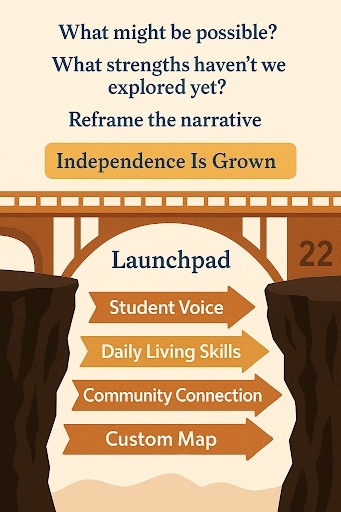
Credit: Donna Phillips
By shifting our narrative from service cliff to launchpad, we reframe the story. We invite possibility. We open space for students to explore dreams, no matter how big or small. Whether it's a part-time job, a supported apartment, or simply the ability to make their own breakfast in the morning—each goal deserves dignity and preparation.
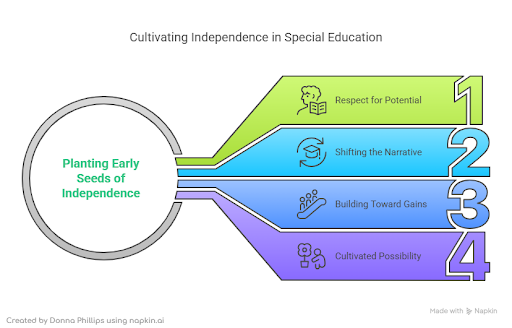
Credit: Donna Phillips
Rooted in Teamwork
This is not a one-person effort. It takes a team. Teachers, families, speech and occupational therapists/specialists, vocational counselors, community partners—we all play a role. And when we collaborate, align, and believe in the long view, we create outcomes that extend far beyond the classroom.
We also collaborate with alumni. Inviting past students to speak to current classes has been transformative. It builds connection and hope. When students hear from someone who once sat in their seat and now holds a job, lives semi-independently, or volunteers, it reframes what’s possible.
Celebrate Every Win
It also takes celebration. Spotlight the sparks that fuel lasting change—celebrating the small wins just as much as the big ones. Completing a load of laundry independently, making a phone call, expressing a preference—these moments are markers of progress. They deserve recognition and reflection. They are the roots that help students grow strong.
We post weekly highlights and "growth moments" in the classroom, creating a visual timeline of progress. We also hold quarterly reflection circles where students name something they’ve accomplished and set a goal for the next term.
Push Systems to Match Student Potential
It’s time we evolve our systems to match our students’ potential. That means better training for educators in transition planning. That means policies that support life-long learning and flexible pathways into adulthood. That means school districts embracing innovation—job coaching programs, in-house work experiences, micro-credentials, and partnerships with local colleges, community partners, and local businesses.
It also means state-level change: increasing post-secondary access programs, enhancing supported employment services, and allowing students to co-author their Individual Transition Plans in meaningful ways.
Ask Students What They Want
Some of the best ideas come from listening directly to students themselves. Ask them what they want. Ask them how they define independence. You may be surprised by the insight they offer when we create space for their voice.
Student-led planning has shifted our approach. One student created a visual checklist for his morning routine and asked that we laminate it for him. Another suggested a peer coaching system for job prep. When we listen, we adapt better.
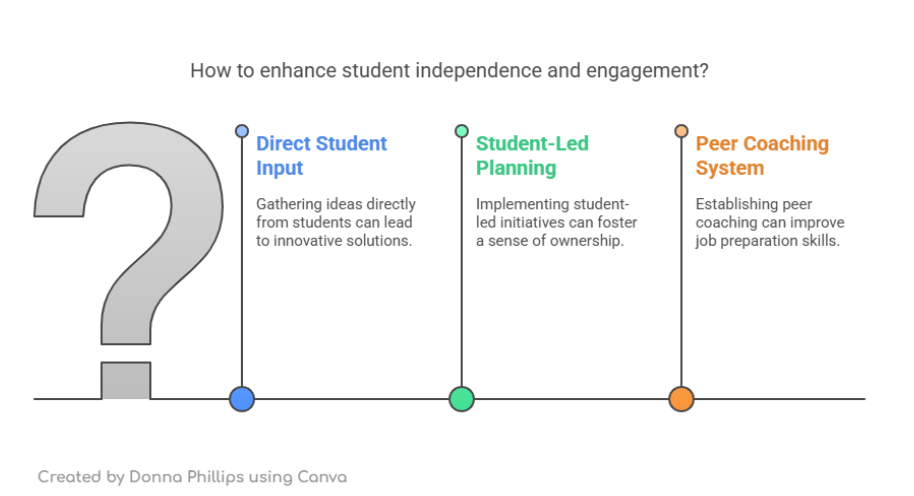
Credit: Donna Phillips
Celebrate Their "Next Steps"
In our self-contained special education program, we close each school year with a celebration called "Next Steps." Families, peers, and community members come together to honor each student’s growth—and their plans for the future. For some, it’s a vocational training program. For others, it's working with a support agency to find a job or develop daily living skills. No matter the path, we center it on purpose and possibility.
We also share success stories through newsletters and school events to showcase real-world examples of how students are thriving. These stories are more than celebrations—they’re roadmaps.
The Heart of the Work
Let’s stop bracing for what students will lose—and start building toward what they can gain.
For many students in self-contained programs, the next step isn’t always college—and that’s okay. Purpose can be found in so many forms: a steady job, a volunteer role, a supported living arrangement, or simply the confidence to make their own breakfast and plan their day. These are real goals. And they matter.
Families also need support to walk this path. Some may feel overwhelmed by paperwork or unsure how to plan for adult services. When we take the time to guide them, answer their questions, and plan together, we’re building something stronger than a checklist—we’re building trust and direction.
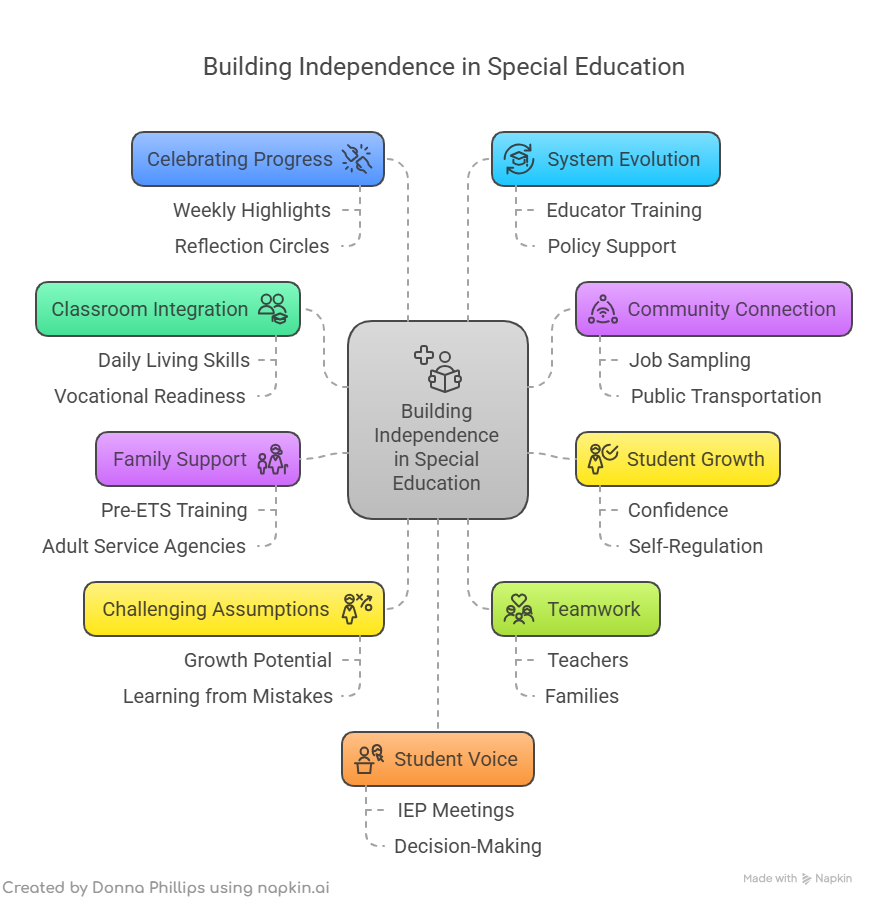
Credit: Donna Phillips
So yes, when our students turn 22, we should absolutely ask: What’s next?
But we should also ask: What have we planted along the way?
Did we create opportunities for voice, for skill-building, for purpose? Because when we plant early, we grow strong. And every student deserves the chance to grow in their own way, in their own time—with a team that believes in what's possible.
References
Phillips, D. (2025, February 7). How Special Education Students Can Benefit From an Adapted 'Circle of Control.' Edutopia. https://www.edutopia.org/article/building-resilience-special-education-circle-of-control
Phillips, D. (2025, March 21). Improving Collaboration Between Special Education and General Education Teachers. Edutopia. https://www.edutopia.org/article/inclusive-classroom-support-strategies-teacher-collaboration
Nevada Department of Employment, Training & Rehabilitation (DETR). Pre-Employment Transition Services (Pre-ETS). https://detr.nv.gov
Think College. National Coordinating Center for Inclusive Postsecondary Education. https://thinkcollege.net
Photo at top by Monstera Production on pexels.

